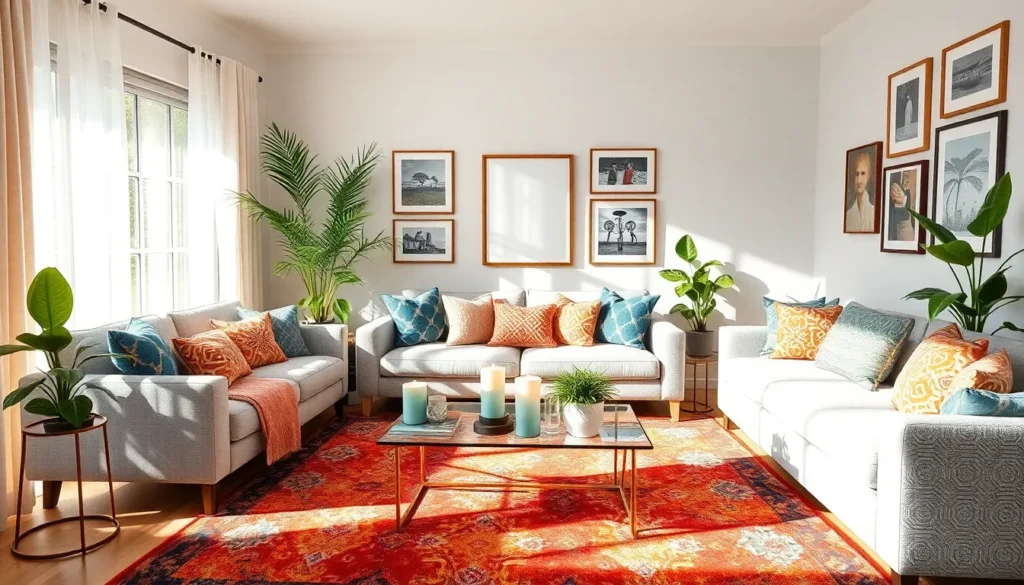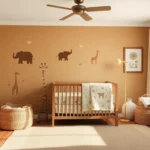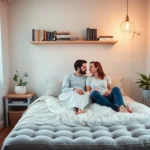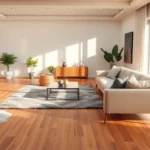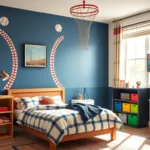We’ve all stood in our living rooms wondering how to transform that blank canvas into a space that truly reflects our personality. Whether you’re starting fresh in a new home or looking to breathe new life into your current space the possibilities can feel both exciting and overwhelming.
The living room serves as the heart of our homes—it’s where we unwind after long days entertain guests and create lasting memories with family. That’s why getting the design just right matters so much. From choosing the perfect color palette to arranging furniture that maximizes both style and functionality every decision shapes how we experience our most-used space.
We’re here to guide you through proven decorating strategies that’ll help you create a living room you’ll absolutely love. These ideas work for any budget style preference or room size so you can finally achieve that magazine-worthy look you’ve been dreaming about.
Create a Cohesive Color Scheme That Sets the Mood
Building upon our foundation of thoughtful design choices, selecting the right colors becomes our next essential step in crafting your dream living room. We’ll explore how strategic color planning transforms your space from ordinary to extraordinary.
Choose a Primary Color Palette
Selecting three main colors creates the backbone of your living room decorating scheme. We recommend using the 60-30-10 rule where your dominant color covers 60% of the space through walls and large furniture pieces. Your secondary color occupies 30% through upholstery, curtains, and medium-sized elements. The remaining 10% becomes your accent color for decorative pieces and artwork.
Neutral palettes offer timeless appeal and versatility for any living room style. Colors like warm beige, soft gray, and creamy white provide a sophisticated foundation that won’t overwhelm your space. These shades work exceptionally well in smaller rooms where we want to maximize the feeling of openness.
Bold color combinations make powerful statements in confident living room designs. Deep navy paired with rich emerald and gold accents creates luxury hotel vibes. Terracotta combined with sage green and cream brings earthy warmth to modern spaces.
Add Accent Colors Through Accessories
Throw pillows serve as the easiest starting point for introducing accent colors into your living room. We suggest choosing 2-3 pillow colors that complement your primary palette while adding visual interest to sofas and chairs. Mix different textures like velvet, linen, and faux fur to create depth alongside your color story.
Artwork becomes a strategic tool for reinforcing your chosen color scheme throughout the room. Select pieces that incorporate your accent colors while introducing new tones that bridge different elements together. Gallery walls offer opportunities to weave multiple accent shades into your living room decorating narrative.
Plants and flowers provide natural accent colors that bring life to any palette. Green foliage complements virtually every color scheme while colorful blooms like pink peonies or orange marigolds can echo your chosen accent hues. Fresh flowers allow us to seasonally adjust our color story without permanent commitment.
Consider the Psychology of Colors
Warm colors including reds, oranges, and yellows create energy and encourage conversation in living spaces. These hues work particularly well in rooms where we entertain frequently or want to stimulate social interaction. But, we recommend using warm colors sparingly in small living rooms as they can make spaces feel more cramped.
Cool colors such as blues, greens, and purples promote relaxation and tranquility in our living areas. Light blue walls can make a room feel larger and more serene, perfect for spaces where we prioritize rest and reflection. Deep forest greens create cozy, sophisticated atmospheres ideal for reading nooks or intimate seating areas.
Neutral colors offer psychological balance and serve as calming backdrops for our daily activities. Gray promotes focus and clarity, making it excellent for home offices that double as living spaces. Beige and cream create welcoming environments that make guests feel comfortable and at ease.
Maximize Natural Light and Layer Your Lighting
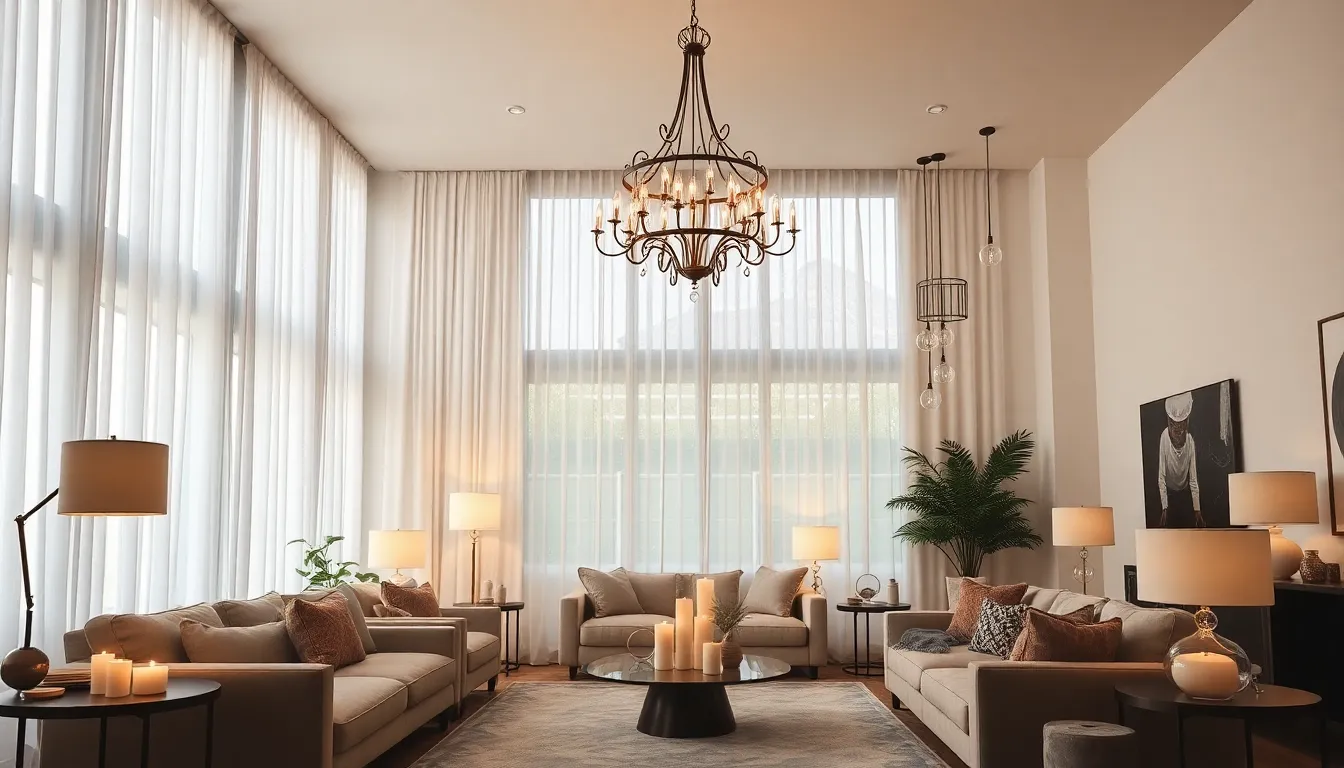
Proper lighting transforms our living room into a brighter, more welcoming space that feels larger and more inviting. We’ll combine natural light optimization with strategic artificial lighting to create the perfect ambiance.
Optimize Window Treatments for Light Flow
Choose lightweight, sheer curtains or blinds that allow sunlight to filter through while maintaining privacy. Sheer fabrics like linen or cotton voile provide softness without blocking precious natural light[1][3]. Heavy, dark window coverings work against our goal of brightening the space, so we avoid them entirely.
Install motorized blinds or adjustable shades for maximum flexibility throughout the day[1]. These treatments let us regulate light flow from morning brightness to evening privacy. Roman shades in light colors offer another excellent option that combines style with functionality.
Position window treatments strategically by mounting curtain rods closer to the ceiling and extending them beyond the window frame. This technique creates the illusion of larger windows and allows maximum light penetration when curtains are open.
Install Statement Light Fixtures
Incorporate bold chandeliers or sculptural pendants as focal points that enhance our room’s design while providing essential illumination[2]. Statement fixtures serve dual purposes by acting as decorative elements and functional lighting sources. Crystal chandeliers, geometric pendant lights, and oversized drum shades all create visual interest.
Select fixtures with reflective finishes like polished chrome, brass, or mirrored surfaces to amplify both natural and artificial light[3][5]. These materials bounce light throughout the room, creating a brighter overall atmosphere. Glass fixtures also contribute to this light multiplication effect.
Position pendant lights strategically over seating areas or above coffee tables for both visual appeal and practical illumination[2]. Multiple pendants at varying heights add depth and dimension to our lighting scheme. Track lighting systems offer flexibility for adjusting light direction as needed.
Add Ambient Lighting with Lamps and Candles
Use floor and table lamps to introduce warm ambient lighting that softens harsh shadows and creates inviting atmospheres[2]. Arc floor lamps work particularly well in corners, while table lamps beside seating areas provide intimate lighting pools. Torchiere lamps bounce light off the ceiling for gentle, diffused illumination.
Place lamps strategically in dark corners and beside seating to eliminate shadows and create balanced lighting throughout the room[2]. Three point lighting—combining overhead, task, and ambient sources—ensures even distribution. Buffet lamps on console tables add both function and style to empty wall spaces.
Incorporate candles and LED string lights for adjustable mood lighting during evening hours[2]. Pillar candles in hurricane glasses provide safe, flickering warmth, while battery operated LED strings offer flexibility without electrical constraints. These elements allow us to customize our lighting based on activities and time of day.
Arrange Furniture for Function and Flow
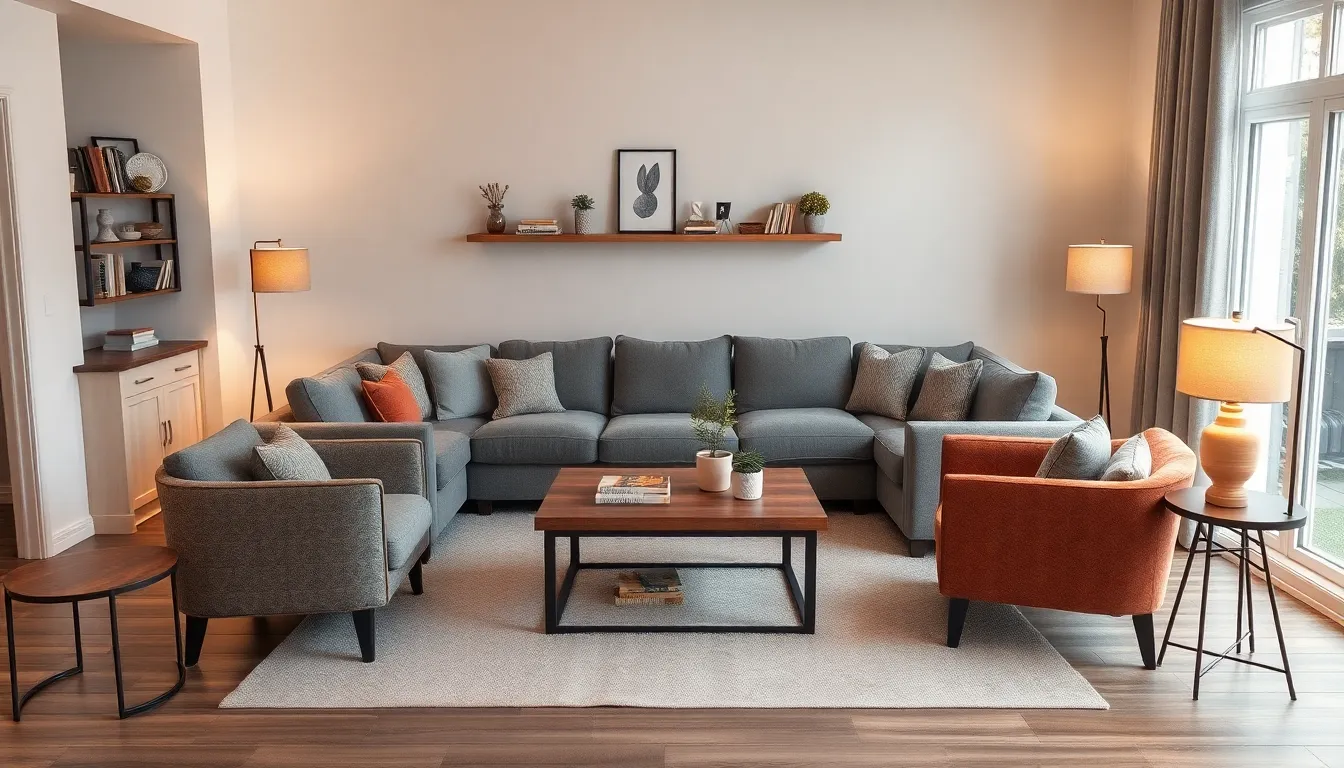
We transform living rooms into functional spaces by strategically positioning each piece to serve both practical needs and aesthetic goals. Smart furniture arrangement creates seamless movement while maximizing every square foot of your room.
Create Conversation Areas
We design inviting conversation spaces by positioning sofas and chairs to face each other at comfortable distances. Arranging seating in a U-shape or L-configuration encourages natural interaction while maintaining intimate conversation flow.
Coffee tables and ottomans serve as central gathering points that anchor these social zones. We place these pieces within easy reach of all seating to create functional surfaces for drinks, books, and decorative items.
Table lamps and floor lamps add warmth to conversation areas through layered lighting. Strategic placement of these fixtures creates cozy pockets of light that draw people together during evening gatherings.
Consider Traffic Patterns
We plan clear pathways by maintaining at least 36 inches of walking space between major furniture pieces. This spacing allows comfortable movement throughout the room without forcing guests to navigate around obstacles.
Doorways and hallways require special attention to prevent furniture placement that creates bottlenecks. We position larger pieces like sofas and entertainment centers away from these high-traffic zones to maintain smooth flow.
Flexible arrangements accommodate different activities by allowing furniture to serve multiple purposes. Ottoman storage pieces can function as extra seating, coffee tables, or footrests depending on your current needs.
Scale Furniture to Room Size
We measure rooms carefully before selecting furniture to ensure pieces fit proportionally within the space. A sectional sofa works beautifully in spacious rooms but can overwhelm smaller living areas where a standard sofa and chairs provide better balance.
Large furniture items require smaller decorative pieces to create visual harmony throughout the room. We balance oversized sofas with delicate side tables, lightweight accent chairs, or slender floor lamps to prevent the space from feeling heavy.
Vertical space maximization comes through wall-mounted shelves and tall furniture pieces that draw the eye upward. Floor-to-ceiling bookcases and statement floor lamps add height while maintaining the room’s open feel at eye level.
Add Texture and Depth Through Fabrics

Layering textiles transforms flat living spaces into rich, inviting environments that feel both comfortable and visually ever-changing. We can achieve this dimensional quality by strategically combining various fabric types and patterns throughout our living room.
Layer Different Textile Materials
Mixing linen, wool, velvet, and cotton creates visual interest and tactile variety that makes our living room feel more captivating. Current trends emphasize combining woven fabrics with smooth or plush textures to achieve a ever-changing and inviting atmosphere.
Creating layers through multiple textile elements involves using curtains, area rugs, upholstered furniture, and wall hangings in complementary but contrasting textures. This approach enhances comfort while defining zones within our living room and softening acoustics naturally.
Incorporating handcrafted textiles like handmade rugs or artisan pillows adds uniqueness to our space while supporting sustainable practices. These pieces often serve as conversation starters and help personalize our living room in meaningful ways.
Mix Patterns and Prints Strategically
Pairing large scale geometric or floral prints with smaller, subtler patterns prevents overwhelming our space while maintaining visual excitement. We should strategically balance bold designs with more understated elements to create harmonious compositions.
Using neutral base textiles as foundations allows bold or colorful patterns to stand out as accent features throughout our living room. Popular pattern choices include botanical motifs, abstract designs, and vintage inspired prints that add character without competing for attention.
Balancing pattern distribution across furniture and accessories ensures our living room feels cohesive rather than chaotic. We can achieve this by limiting ourselves to 2-3 different pattern scales and keeping colors within our established palette.
Incorporate Throw Pillows and Blankets
Adding throw pillows and blankets introduces pattern, color, and softness without requiring major decorating commitments. These elements can be easily swapped to update our living room’s look as tastes or seasons change.
Layering pillows of varying sizes and textures on sofas or chairs adds dimension and coziness to our seating areas. We should mix different shapes, from square to lumbar, while maintaining our color scheme for visual unity.
Draping blankets over furniture or storing them in baskets contributes to a lived in, hospitable atmosphere that welcomes relaxation. This approach allows us flexibility for seasonal updates while maintaining comfort and style throughout the year.
Incorporate Wall Art and Personal Touches
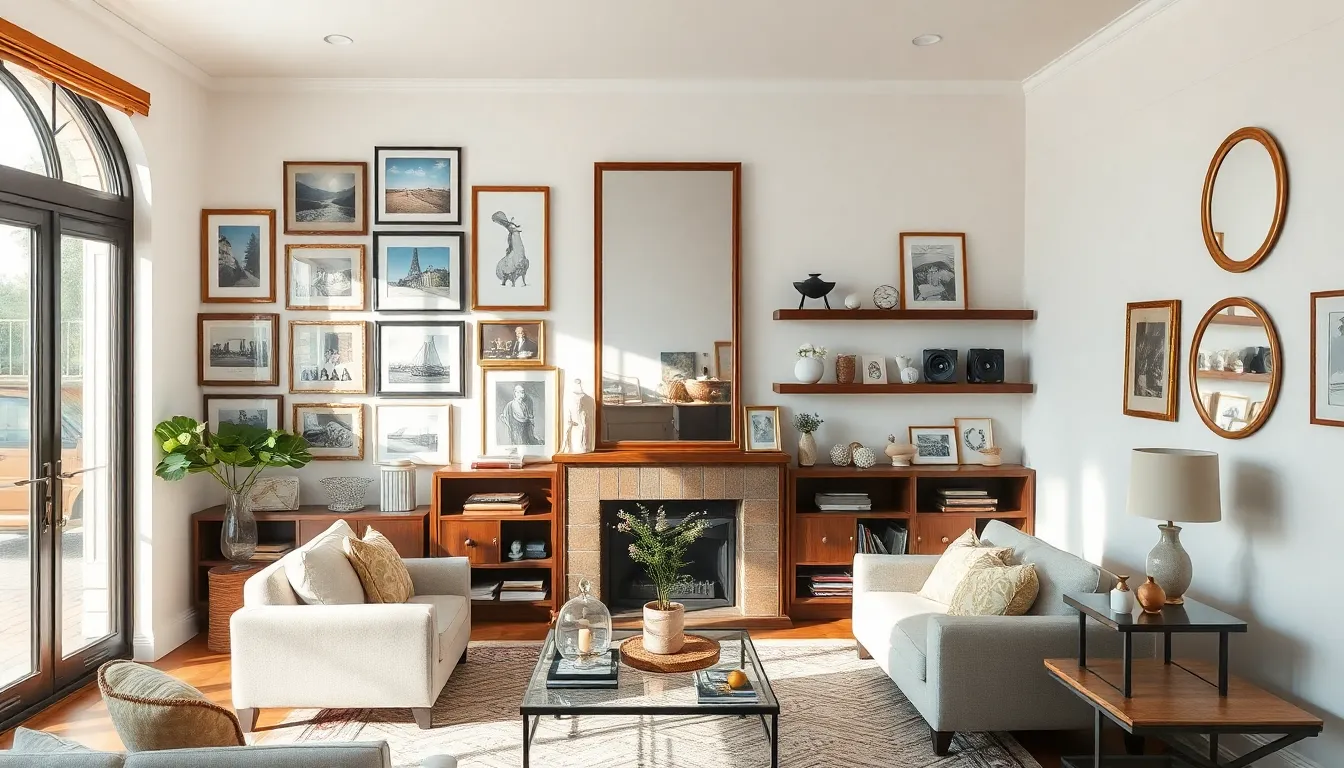
Transforming your living room into a reflection of your personality requires thoughtful placement of meaningful artwork and cherished personal items. We’ll explore how strategic wall art and personal collections can elevate your space while creating visual interest and emotional connection.
Create Gallery Walls
Gallery walls offer an exceptional opportunity to display multiple pieces while creating a stunning focal point. We recommend mixing frame styles such as white, black, and wood finishes to add character and visual depth to your arrangement.
Combining different textures and materials creates the most captivating gallery displays. Paintings, photographs, and prints work together to form an eclectic mix that captures attention and sparks conversation.
Planning your layout before hanging ensures the best results. We suggest laying pieces on the floor first to experiment with arrangements, keeping 2-3 inches between frames for optimal spacing.
Family portraits and travel memories make excellent centerpieces for gallery walls. These personal elements transform a simple wall display into a meaningful storytelling feature that guests will enjoy exploring.
Display Personal Collections
Personal collections deserve prominent placement where they can be appreciated and protected. Shelves and glass cases provide ideal showcasing opportunities for art pieces, sculptures, and collectibles while keeping them dust free.
Vintage items add instant character and conversation starters to any living room. Antique furniture pieces, decorative objects, and inherited treasures create layers of history that make spaces feel lived in and loved.
Books become decorative elements when arranged thoughtfully on open shelving. We recommend grouping books by color or size while leaving space for small decorative objects to create visual breaks.
Rotating displays keep your collections fresh and prevent visual clutter. Seasonal changes allow you to highlight different pieces throughout the year while maintaining an organized appearance.
Add Mirrors to Enhance Space
Mirrors create the illusion of larger rooms while adding essential depth to compact living areas. Strategic placement opposite windows maximizes natural light reflection throughout the day.
Decorative mirrors in unique shapes and frames contribute significantly to your room’s overall aesthetic. Round mirrors soften angular furniture lines, while geometric shapes add contemporary flair.
Grouping smaller mirrors creates more visual impact than single large pieces in certain arrangements. We suggest using odd numbers and varying sizes for the most pleasing compositions.
Positioning mirrors at eye level ensures they serve both functional and decorative purposes effectively. Avoid placing them directly across from each other to prevent creating infinity reflections that can feel disorienting.
Bring Nature Indoors with Plants and Greenery
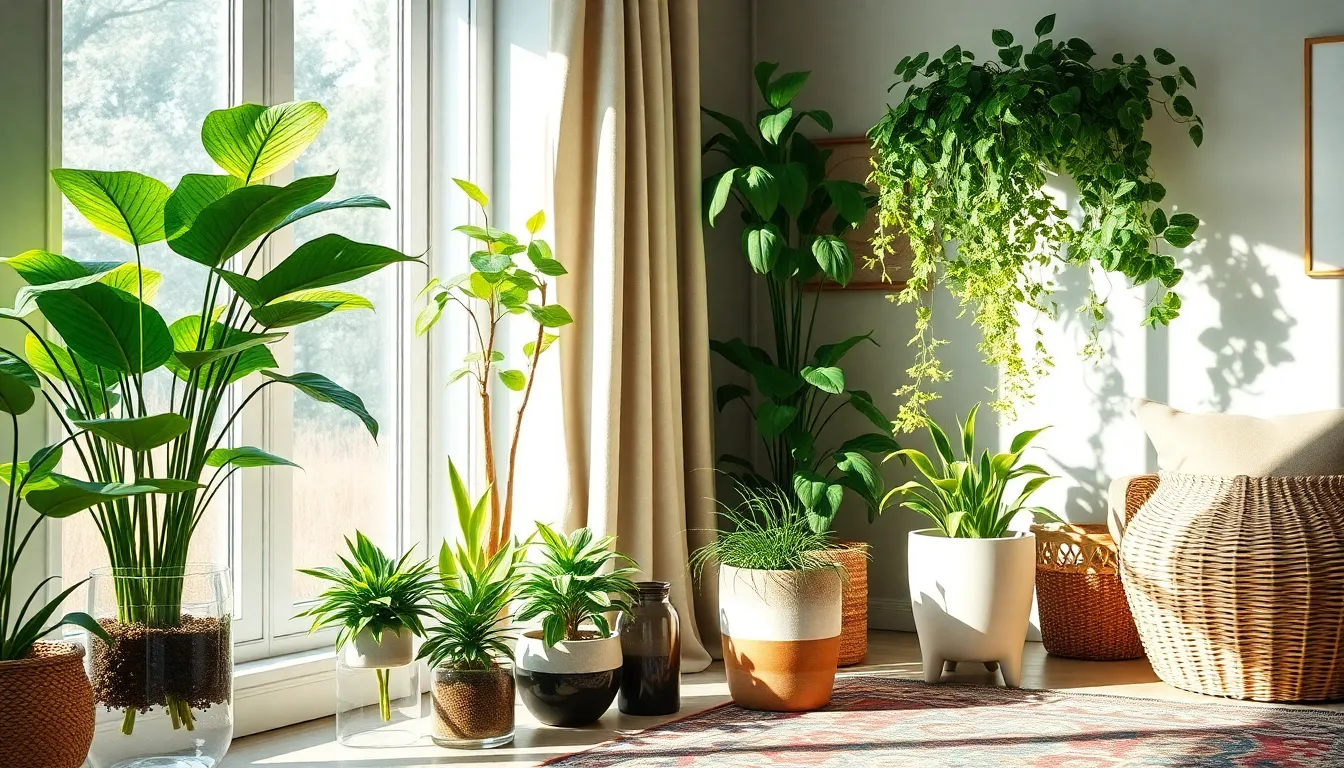
Adding plants to your living room creates a fresh, vibrant atmosphere while improving air quality and bringing life to your space.
Choose Low-Maintenance Indoor Plants
Selecting plants that thrive with minimal care ensures your green additions remain beautiful without overwhelming your schedule. Umbrella Plants offer an excellent starting point for beginners, growing well in medium, indirect sunlight and requiring very little attention. Areca Palms provide dual benefits by purifying the air while preferring medium light conditions and needing only infrequent watering sessions.
Drought resistant options like the String of Pearls work perfectly for those who travel frequently or prefer minimal maintenance routines. These cascading beauties thrive in hanging planters and can survive extended periods without water. Consider these low maintenance varieties when building your indoor garden collection.
Use Planters as Decorative Elements
Transform ordinary containers into stunning design features that complement your living room’s aesthetic. Glass containers add transparency and elegance to any space, working particularly well for displaying small plants like succulents or air plants. Ceramic planters offer versatility in style, providing either rustic charm or sleek modern appeal depending on their design and finish.
Wicker baskets bring natural, earthy textures that pair beautifully with plants like the Twister Lipstick Plant. Choose planters that match your existing decor colors and materials to create a cohesive look throughout your room.
Create Plant Groupings for Impact
Arranging plants in thoughtful clusters creates visual drama and maximizes their decorative impact. Mix different textures by combining lush ferns with spiky succulents and trailing vines to add depth and visual interest to your displays. Layer various sizes strategically by placing tall floor plants in corners, medium sized plants on shelves or plant stands, and small plants on coffee tables or side tables.
Add greenery accents through terrariums and hanging plants to create unique vertical displays that draw the eye upward. Group plants in odd numbers like three or five for the most pleasing visual arrangement, and vary their heights to create ever-changing compositions that enhance your living room’s natural beauty.
Optimize Storage While Maintaining Style

Smart storage answers transform cluttered living rooms into organized, visually appealing spaces without sacrificing design integrity. We’ll explore practical approaches that maximize functionality while preserving your room’s aesthetic appeal.
Use Multi-Functional Furniture
Coffee tables with hidden compartments serve as perfect storage answers for remote controls, magazines, and board games while maintaining their role as central gathering points. Ottoman seating that opens to reveal storage space provides both comfortable seating and practical organization for blankets, pillows, and seasonal items.
Sofas with built-in drawers maximize floor space by eliminating the need for additional storage furniture. These pieces reduce visual clutter while supporting a clean, modern aesthetic that complements any decorating style.
Dressers and buffets originally designed for bedrooms and dining rooms work exceptionally well in living spaces. We can repurpose these pieces to store media equipment, blankets, and entertainment supplies while serving as unique decorative elements that add character to the room.
Incorporate Built-In Storage Answers
Floor-to-ceiling bookshelves create dramatic storage walls that integrate seamlessly with existing room layouts. Custom cabinetry matches your room’s materials and finishes, ensuring storage answers enhance rather than detract from your overall design scheme.
Wall units offer ample space for books, electronics, and decorative items while maintaining visual continuity. Adjustable shelving adapts to accommodate various item sizes, from large picture frames to small collectibles.
Mixing open and closed compartments balances display opportunities with practical storage needs. Closed sections hide less attractive items like cables and paperwork, while open areas showcase books, art pieces, and personal collections.
Style Open Shelving Effectively
Floating shelves provide both storage and style opportunities when arranged with varying heights and colors. Curated displays using books, artwork, and decorative vases highlight personal taste while keeping surfaces organized and clutter-free.
Strategic arrangement of items creates visual interest through thoughtful grouping and spacing. Books can be arranged both vertically and horizontally, with decorative objects placed in front to break up monotonous lines.
Secure installation ensures shelves remain both safe and attractive features in your living room. Proper wall anchoring supports heavier items while maintaining the clean, floating appearance that enhances modern room aesthetics.
Define Spaces with Area Rugs
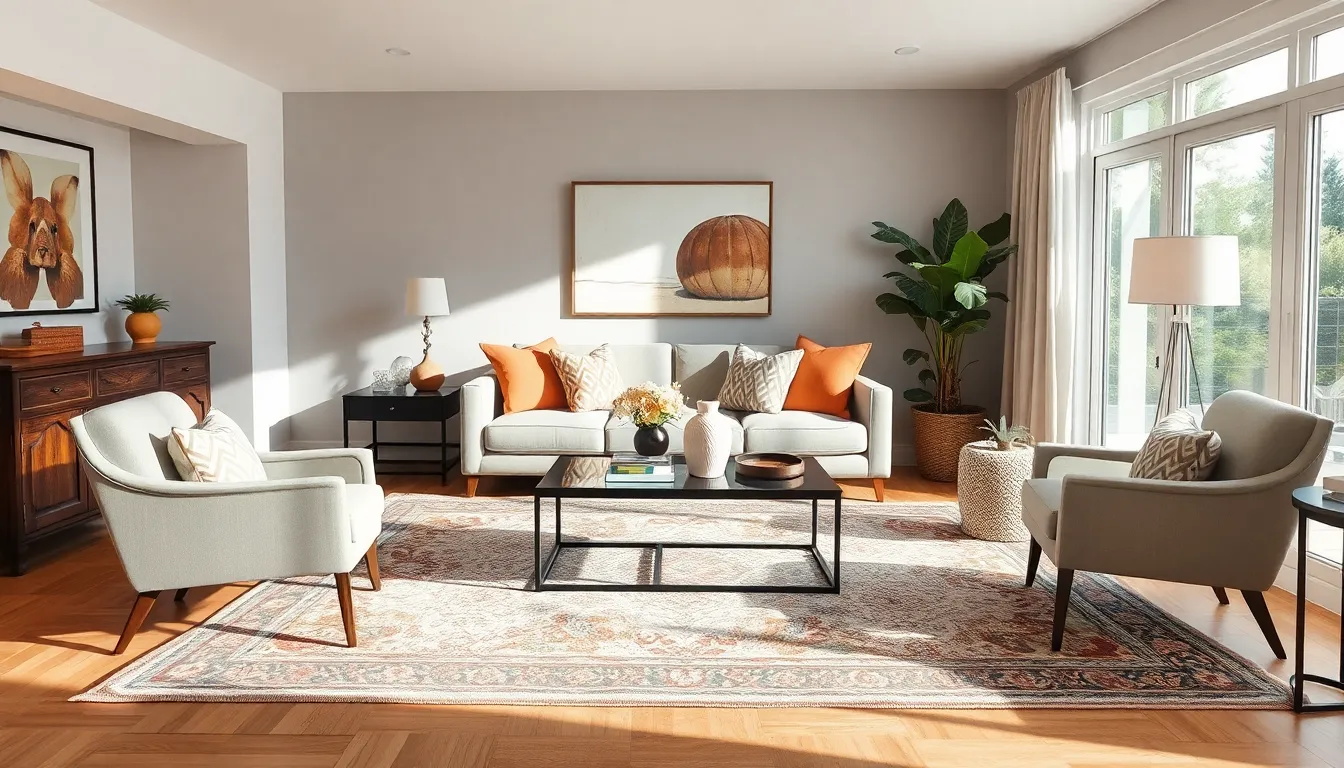
Area rugs transform living rooms by creating distinct zones within open floor plans and establishing clear boundaries between seating areas and dining or entry spaces. We’ll explore how strategic rug placement makes rooms feel more organized and inviting.
Choose the Right Size Rug
Anchor your furniture properly by selecting rugs large enough to accommodate at least the front legs of major pieces like sofas and armchairs. Ideally, we recommend extending the rug so all key furniture sits on it, creating a cohesive look that ties the seating area together.
Avoid common sizing mistakes that can disrupt your room’s visual flow. Small rugs make spaces feel disjointed and fragmented, while oversized rugs may overwhelm the room and throw off proportions. Measure your seating area carefully and choose a rug that complements rather than competes with your furniture arrangement.
Consider your room’s layout when determining rug dimensions. We suggest measuring the distance between your main seating pieces and adding 24 to 36 inches to ensure the rug extends beyond the furniture edges, creating a grounded appearance that enhances your living room’s overall design.
Layer Rugs for Added Interest
Create visual depth by layering a smaller patterned or textured rug over a larger, neutral foundation piece. This technique adds dimensional interest while introducing additional texture and color combinations that enhance your existing decor scheme.
Maximize decorating flexibility through strategic rug layering that allows you to update your living room’s appearance without replacing large, expensive items. We can easily swap out the top layer seasonally or when our style preferences evolve, maintaining freshness in our decorating approach.
Balance textures and patterns when selecting layered rugs by combining different materials like jute, wool, or cotton. Pair smooth, flat weaves with textured pieces or neutral bases with bold accent rugs to achieve sophisticated contrast that elevates your living room’s visual appeal.
Select Patterns That Complement Your Decor
Match existing color schemes by choosing rug patterns that echo colors already present in your living room furniture, artwork, or accessories. Patterns can add energy to neutral palettes or help tie together different furniture pieces for a cohesive, well designed appearance.
Coordinate with your furnishings by avoiding overly busy patterns unless paired with simpler furniture and decor elements. We recommend selecting designs that complement rather than compete with existing patterns in your upholstery, throw pillows, or window treatments.
Echo design elements found elsewhere in your room to create visual harmony throughout the space. Look for rug patterns that repeat geometric shapes, color combinations, or stylistic themes present in your artwork, lighting fixtures, or architectural details for a thoughtfully curated living room aesthetic.
Add Architectural Interest with Molding and Trim
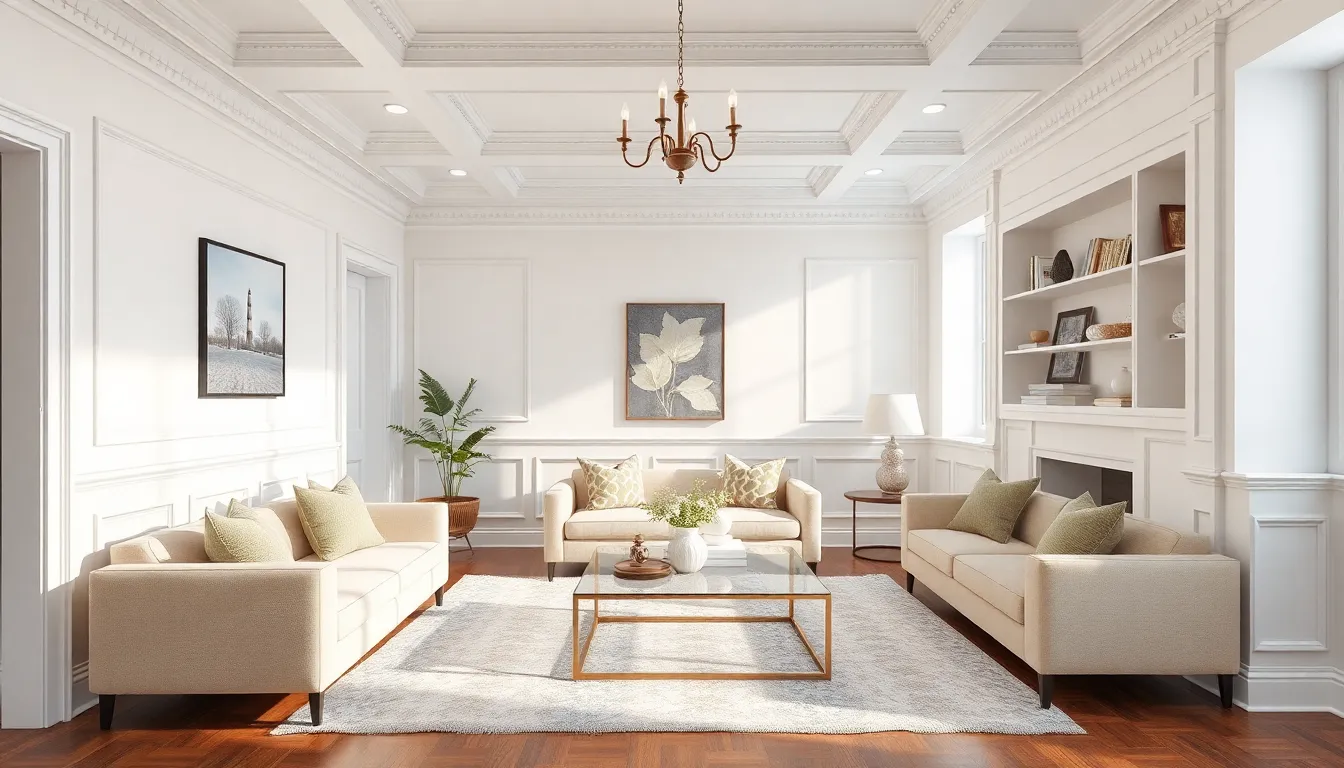
Building on our foundation of thoughtful design elements, we can transform ordinary walls into sophisticated architectural features that elevate our living room’s overall aesthetic.
Install Crown Molding and Baseboards
Crown molding creates an elegant transition between walls and ceilings while adding visual height to our living space. This classic architectural detail draws the eye upward and makes rooms feel more spacious and refined. We’ll find that crown molding works particularly well in rooms with standard 8-foot ceilings, where it can create the illusion of greater vertical space.
Baseboards provide the finishing touch that creates cohesive visual flow throughout our living room. Beyond their aesthetic appeal, baseboards serve the practical purpose of protecting our walls from damage caused by furniture, vacuum cleaners, and daily foot traffic. We should select baseboards that complement our crown molding style, ensuring both elements work together to frame our walls beautifully.
Create Wainscoting or Panel Details
Wainscoting transforms the lower portion of our walls by adding paneling that introduces both texture and visual depth. This traditional technique works especially well in living rooms where we want to create a more formal or sophisticated atmosphere. We can choose from various wainscoting styles, including classic raised panels or more contemporary flat panel designs that suit our overall decor theme.
Panel details extend beyond traditional wainscoting to include board and batten patterns that add striking visual interest to our walls. These vertical lines create ever-changing focal points while maintaining clean, modern aesthetics that complement contemporary furniture arrangements. We’ll discover that panel details work particularly well on accent walls behind our seating areas or entertainment centers.
Add Built-In Shelving or Alcoves
Built-in shelving creates dedicated storage and display areas that seamlessly integrate with our living room’s architecture. These custom answers eliminate the need for standalone bookcases while providing designated spaces for our decorative items, books, and personal collections. We can design built-in shelving to flank our fireplace, frame our entertainment center, or fill unused wall space with functional beauty.
Alcoves serve as architectural features that highlight exact pieces of art or furniture, creating natural focal points within our living room layout. These recessed areas draw attention to our most treasured items while adding dimensional interest to otherwise flat wall surfaces. We should consider incorporating lighting within our alcoves to enhance their dramatic effect and showcase our displayed pieces effectively.
Incorporate Statement Pieces as Focal Points
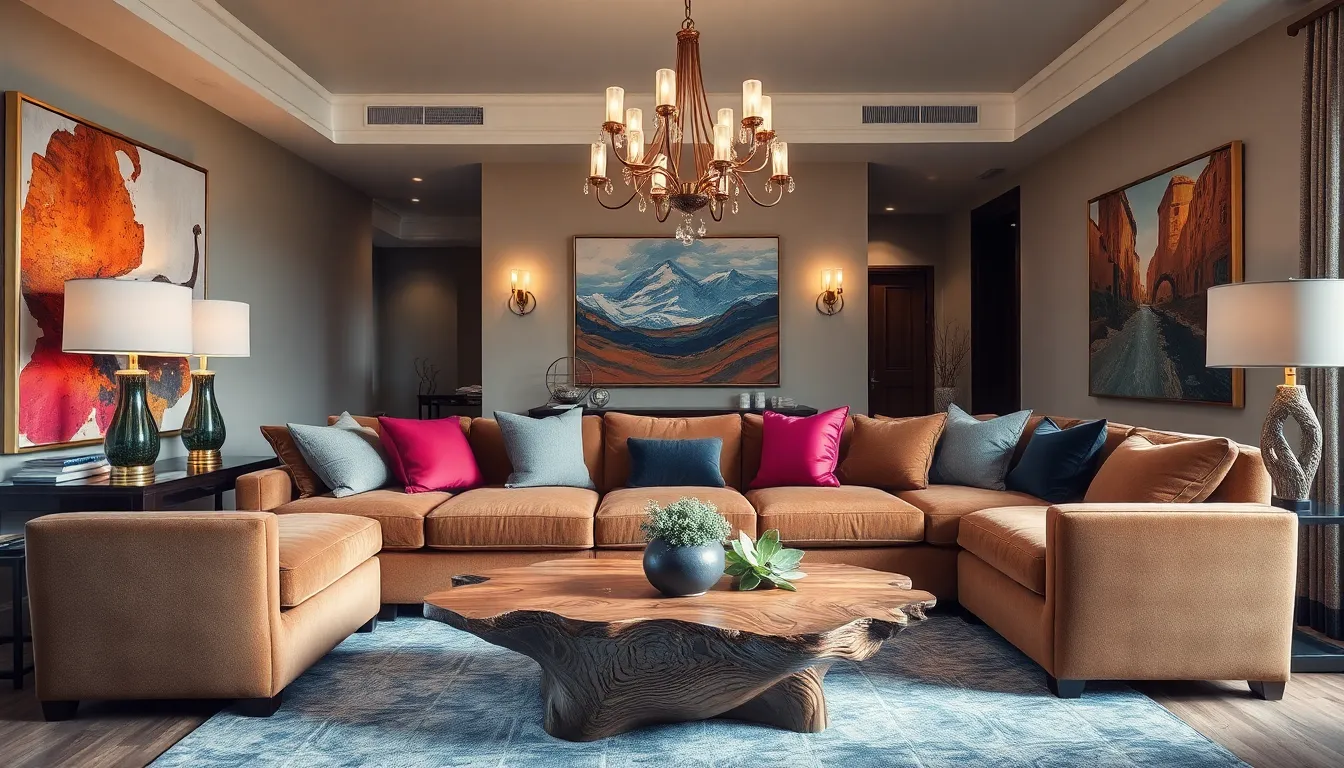
We’ve covered the foundation elements of living room design, and now it’s time to elevate your space with carefully chosen statement pieces that command attention. These bold additions serve as conversation starters and reflect your unique personality while maintaining the cohesive aesthetic you’ve established.
Choose One Bold Furniture Piece
Select a single standout furniture item to avoid overwhelming your carefully curated space with visual clutter. A luxurious three-cushion sofa in rich fabric can transform your entire living room into an elegant retreat. Chaise lounges offer both dramatic appeal and functional seating that encourages relaxation and adds sophisticated curves to rectangular room layouts.
Sculptural coffee tables made from unique wood grain or unexpected materials like stone create immediate focal points that guests notice upon entering. These pieces should complement your existing color scheme while serving practical purposes for daily living. Balance scale with function by ensuring your statement piece fits proportionally within your room dimensions without blocking traffic flow.
Leather sofas and fabric recliners in vibrant hues bring warmth and depth to neutral palettes established earlier in your design process. Choose pieces that echo accent colors from your artwork or throw pillows to maintain visual harmony throughout the space.
Add Oversized Artwork or Sculptures
Oversized artwork captures attention immediately and evokes emotional responses that smaller pieces simply cannot achieve. Ever-changing sculptures mixed with traditional paintings create compelling layers of interest that reflect sophisticated design sensibilities. Position large artworks at eye level on prominent walls where they won’t compete with your statement furniture piece for attention.
Align artwork style and palette with your room’s established aesthetic to ensure seamless integration rather than jarring contrast. Modern abstract pieces complement contemporary furniture while classical paintings enhance traditional decor schemes. Gallery walls featuring oversized central pieces surrounded by smaller complementary works create museum-quality displays in residential settings.
Sculptural elements placed on side tables or in corners add three-dimensional interest that flat artwork cannot provide. These pieces work especially well in minimalist spaces where their forms can be appreciated without visual competition.
Install Eye-Catching Light Fixtures
Unique lighting fixtures enhance ambiance while serving as stunning architectural elements that draw eyes upward and expand perceived room height. Oversized chandeliers suspended over seating areas create intimate conversation zones while providing functional illumination for evening activities. Minimalist sconces flanking artwork or mounted along accent walls offer sophisticated lighting answers that complement rather than compete with other statement pieces.
Consider fixture scale relative to room proportions to ensure your lighting choices enhance rather than overwhelm your carefully planned layout. Statement pendants work particularly well in rooms with high ceilings where their dramatic presence can be fully appreciated. Coordinate finish materials with existing hardware on furniture and window treatments to maintain cohesive design flow throughout your living space.
Layer statement lighting with ambient sources like table lamps and floor fixtures to create adjustable mood settings for different occasions. This approach allows your eye-catching fixtures to serve as focal points during entertaining while providing functional task lighting for daily activities.
Conclusion
We’ve covered everything you need to transform your living room into a space that truly reflects your personal style while maintaining functionality. From establishing cohesive color schemes and optimizing lighting to arranging furniture for better flow and incorporating meaningful personal touches – each element works together to create your ideal retreat.
Remember that great living room design doesn’t happen overnight. Start with one or two key changes that resonate most with your vision and budget. Whether it’s adding statement lighting or introducing more texture through layered textiles you’ll begin to see immediate improvements in how your space feels and functions.
The beauty of these decorating strategies lies in their flexibility. You can adapt them to any budget style preference or room size. Most importantly trust your instincts and choose elements that make you feel comfortable and happy in your own home.
Frequently Asked Questions
What is the 60-30-10 rule for living room color schemes?
The 60-30-10 rule is a proven color formula where 60% of your room uses a dominant color (walls and large furniture), 30% features a secondary color (upholstery and medium elements), and 10% incorporates an accent color (decorative pieces). This creates a balanced, cohesive look that’s visually appealing and professional.
How can I maximize natural light in my living room?
Use lightweight, sheer window treatments that filter sunlight while maintaining privacy. Position mirrors strategically to reflect and amplify natural light throughout the space. Keep window areas uncluttered and consider light-colored walls and furniture to bounce light around the room more effectively.
What’s the ideal spacing for living room furniture arrangement?
Maintain at least 36 inches of walking space between major furniture pieces to ensure comfortable traffic flow. Create conversation areas by positioning sofas and chairs to face each other, with coffee tables placed within easy reach (typically 14-18 inches from seating).
How do I choose the right size area rug for my living room?
Your area rug should anchor your furniture grouping. For most living rooms, all front furniture legs should sit on the rug, or at minimum, the front legs of sofas and chairs. Common sizes are 8×10 feet for standard rooms and 9×12 feet for larger spaces.
What are some low-maintenance plants perfect for living rooms?
Umbrella Plants, Areca Palms, Snake Plants, and Pothos are excellent low-maintenance options. These plants thrive in indoor conditions, require minimal watering, and effectively improve air quality while adding natural beauty to your living space without demanding extensive care routines.
How can I add storage without sacrificing style?
Choose multi-functional furniture like coffee tables with hidden compartments and storage ottomans. Install floor-to-ceiling built-in shelving and use decorative baskets or boxes. Open shelving can display curated items while keeping surfaces organized and maintaining your room’s aesthetic appeal.
What’s the best way to create a gallery wall?
Mix frame styles, sizes, and textures for visual interest. Start by laying out your arrangement on the floor before hanging. Maintain 2-3 inches between frames and hang the center of your gallery at eye level (57-60 inches from the floor).
How do I layer lighting effectively in my living room?
Combine three types of lighting: ambient (overhead fixtures), task (table and floor lamps), and accent (candles, string lights). Use dimmer switches for adjustability and place lamps at different heights throughout the room to create warm, inviting atmospheres for various activities.

